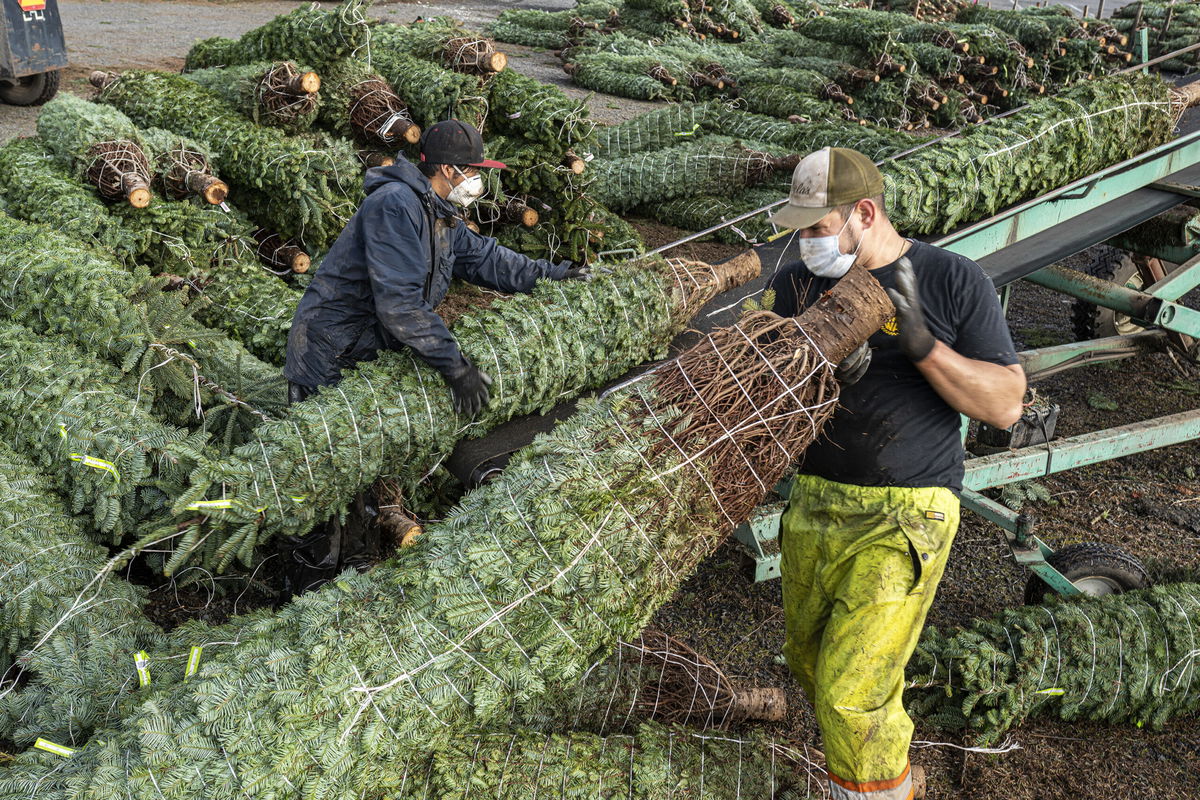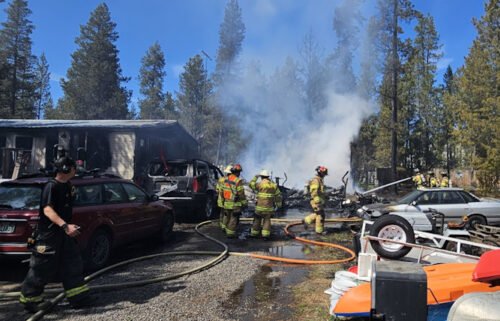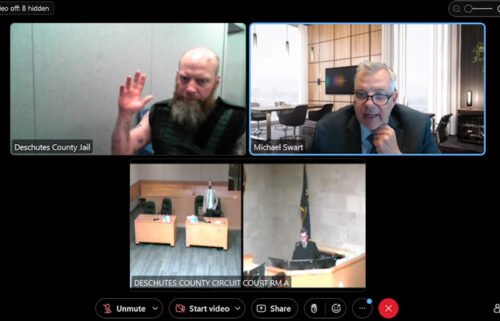Natural vs. artificial: Which Christmas tree option is better for the climate?

Grounds crew load cut and packaged Christmas trees onto trucks at Noble Mountain Tree Farm in Salem
By Rachel Ramirez, CNN
It’s the time of the year when most Americans finish Thanksgiving leftovers and venture out in search for the best holiday sales. More importantly, they plan their household centerpiece of the season: the Christmas tree.
While some revel in the scent of a real tree and the joy of picking one out at a local farm, others prefer the simplicity of artificial trees they can reuse for Christmases to come.
But consumers are becoming more climate-conscious, and considering which tree has the lowest impact on our rapidly warming planet has become a vital part of the holiday decision. Plus, choosing a planet-friendly tree will likely get you on Santa’s good list.
So, which kind of tree has the lowest carbon footprint — a natural tree or a store-bought plastic tree? It’s complicated, experts say.
“It’s definitely a lot more nuanced and complex than you think,” Andy Finton, the landscape conservation director and forest ecologist for the Nature Conservancy in Massachusetts, told CNN.
We’ve made a list — and checked it twice — of the things to know before you choose between real and artificial.
The case for artificial trees
It’s easy to imagine that reusing an artificial tree year after year is the more sustainable option. But Finton says if an artificial tree is used for fewer than six years, the carbon cost is greater than investing in a natural tree.
“If the artificial trees are used for a longer lifespan, that balance changes,” Finton told CNN. “And I’ve read that it would take 20 years for the carbon balance to be about equivalent.”
That’s because artificial trees are typically made of polyvinyl chloride plastic, or PVC. Plastic is petroleum-based and created at pollution-belching petrochemical facilities. Studies have also linked PVC plastic to cancer and other public health and environmental risks.
Then there’s the transportation aspect. According to the US Department of Commerce, most artificial Christmas trees are imported into the US from China, meaning the products are carried by fossil fuel-powered ships across the Pacific Ocean, then moved by heavy freight trucks before it ultimately lands on the distributor’s shelves or the consumer’s doorstep.
The American Christmas Tree Association, a nonprofit that represents artificial tree manufacturers, commissioned WAP Sustainability Consulting for a study in 2018 that found the environmental impact of an artificial tree is better than a real tree if you use the fake tree for at least five years.
“Artificial trees were looked at [in the study] for factors such as manufacturing and overseas transportation,” Jami Warner, executive director of ACTA, told CNN. “Planting, fertilizing and watering were taken into account for real trees, which have an approximate field cultivation period of seven to eight years.”
What are the benefits of real trees?
On average, it takes seven years to fully grow a Christmas tree, according to the National Christmas Tree Association. And as it grows, it absorbs carbon dioxide from the air. Protecting forests and planting trees can help stave off the worst impacts of the climate crisis by removing the planet-warming gas from the atmosphere.
If trees are cut down or burned, they can release the carbon they’ve been storing back into the atmosphere. But Doug Hundley, spokesperson for the National Christmas Tree Association, which advocates for real trees, says the act of cutting down Christmas trees from a farm is balanced out when farmers immediately plant more seedlings to replace them.
“When we harvest the trees or cut them, we plant back very quickly,” Hundley said.
If the idea of trekking through a forest to find the perfect tree is intriguing, you can buy a permit from the US Forest Service, which encourages people to cut their own tree rather than buy an artificial one. According to Recreation.gov, cutting down thin trees in dense areas can improve forest health.
But Finton doesn’t recommend pulling a Clark Griswold and chopping down a massive tree to haul home — especially if it’s in an area you’re not permitted for. He recommends getting a tree from a local farm, instead.
“To me, the benefit of going to a Christmas tree farm, which is different than cutting a tree in the forest, is that it concentrates the impact of removing trees into one location,” he said. “And it puts the responsibility on the farmers to regenerate those trees.”
There’s also an economic benefit to going natural, since most of the trees people end up getting are grown at nearby farms. About 15,000 farms grow Christmas trees in the US alone, employing over 100,000 people either full or part-time in the industry, according to the National Christmas Tree Association.
“What we’re doing by purchasing a natural Christmas tree is supporting local economies, local communities, local farmers and to me, that’s a key part of the conservation equation,” Finton said. “When a tree grower can reap economic benefits from their land, they’re less likely to sell it for development and less likely to convert it to other uses.”
Disposal matters
Trees pile up on the curbs after the holidays are over, and the final destination in many locations is landfills, where they contribute to emissions of methane — a powerful greenhouse gas roughly 80 times more potent that carbon dioxide.
“Real Christmas trees ending up in landfills is very much discouraged,” Hundley said, adding that there needs to be “separate areas for yard waste where Christmas trees can go.”
But some towns and cities repurpose the trees to benefit the climate and the environment. In New York City, trees left on curbs during a certain timeframe are picked up to be recycled or composted. The city sanitation department also hosts an initiative called MulchFest, where residents can bring their trees to be chipped for mulch and used to nourish other trees throughout the city.
“When the tree is finished being used by the homeowner, it’s very easy and and common in America to have the tree chipped up into mulch — and that’s stored carbon is put back in the ground,” Hundley added.
Finton also says former Christmas trees can be reused for habitat restoration; they can help control erosion if placed along stream and river banks, and can even help underwater habitats thrive if they are placed in rivers and lakes.
The end of life for an artificial tree is much different. They end up in landfills — where they could take hundreds of years to decompose — or incinerators, where they release hazardous chemicals.
The bottom line
Weighing the complicated climate pros and cons, real Christmas trees have the edge. But if you choose to deck your halls artificially, get a tree you’re going to love and reuse for many years.
Either way, Finton said, people should feel good about their decision and find other ways to tackle the climate crisis.
“It’s a debate, but once you’ve made a decision, you should feel good about your decision, because there’s so many other things we can do in our lives that have an even greater climate impact — such as driving less or advocating for policies that expand renewable energy,” Finton said. “Enjoy the holidays and focus on other aspects of your life to reduce the impacts of climate change.”
The-CNN-Wire
™ & © 2021 Cable News Network, Inc., a WarnerMedia Company. All rights reserved.



